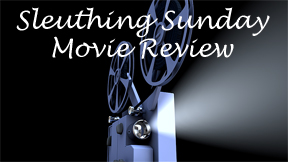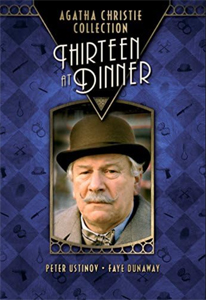The third of Peter Ustinov’s six Hercule Poirot films, “Thirteen at Dinner” (1985), came out the same year as “Back to the Future.” This is fitting since Ustinov’s Poirot inexplicably jumps from the period pieces of “Death on the Nile” and “Evil Under the Sun” a half-century forward for this mystery.
The real-world reason is likely that TV movies had lower budgets than theatrical films at the time, so an easy cost-saver for CBS was to make “Thirteen at Dinner” contemporary – as would also be the case with 1986’s “Dead Man’s Folly” and “Murder in Three Acts.” Then in 1988, he’d return to a period piece – and to the big screen — for “Appointment with Death.”
This is a “Please just go with it” situation presented by writer Rod Browning and director Lou Antonio. And this adaptation of Agatha Christie’s 1933 classic (also titled “13 at Dinner” and “Lord Edgware Dies”) is solid enough that I did eventually go with it.

“Thirteen at Dinner” (1985)
Director: Lou Antonio
Writers: Rod Browning (screenplay), Agatha Christie (novel)
Stars: Peter Ustinov, Faye Dunaway, David Suchet
Christie’s plot remains the star
The film’s strength lies in Christie’s plotting and Browning’s wise choice to leave it alone, along with Antonio’s effective staging of scenes that include both actress Jane Wilkinson and impressionist Carlotta Adams. Both are played by Faye Dunaway.
As fans of the novel know, skilled impressionist Adams is running loose somewhere among the recounted events. But we don’t know where, how or why. The seemingly simple brain-teaser becomes cleverly complex under Christie’s pen.
Browning’s major Eighties addition is an almost absurdist portrayal of celebrity culture’s emphasis on image over reality. Actor Bryan Martin (Lee Horsley, resembling Tom Selleck thanks to a mustache) is seen doing heroic appearances to cap scenes driven by his stunt man. The London director fawns over him, thrilled to have this American star on his soil. Martin is amusingly ridiculous, but we should also be thinking of the phoniness of Jane.
Comedy doesn’t quite connect
In early scenes of Jane leaving Poirot a quivering mess, Ustinov overplays the detective’s penchant for being thrown off by beautiful women. But later, when he’s in his element of revealing the solution to the assembled players in a grand theater (where Martin’s film is shooting), Poirot’s healthy ego returns. Both Ustinov and Poirot start slowly, then rediscover their skills.
As is the case in too many adaptations, this one adds comedy (or rather failed comedy) to Christie’s work, particularly with annoyingly jaunty music during transitions. Later, Poirot and Hastings find themselves backstage at a fashion show with partially clad women, and that itself is supposed to be funny. A gag or one-liner about how the old-fashioned Poirot and Hastings are out of their time element might’ve been effective.

But then things settle down and Christie’s puzzle takes precedence. And Ustinov is allowed to play Christie-style comedy in one laugh-out-loud scene where Poirot fakes clumsiness in order to swap a woman’s eyeglasses.
Introducing David Suchet … as Japp?
“Thirteen at Dinner’s” casting is solid, featuring several actors who look similar (befitting the fake-identity theme) yet different enough that we’re not confused. For the first time in the Ustinov-verse, Captain Hastings and Inspector Japp join the fold. Jonathan Cecil plays Hastings more on the milquetoast side than Hugh Fraser fans are accustomed to, but he’s fine as Poirot’s sounding board.
Japp, meanwhile, is played by none other than David Suchet, four years before he’d don Poirot’s mustaches. While the actor has expressed embarrassment with this entry in his resume, I think he’s fine as the workmanlike inspector, even if Japp’s accent cuts in and out. In scenes with both Ustinov and the non-mustachioed Suchet, I didn’t forget that Ustinov is Poirot (for now).
Antonio’s film can’t entirely shake its time-hopping oddness. The contemporary Eighties setting – and Poirot’s out-of-time presence — stay in my mind throughout. But the story’s plotting eventually engages my attention more. I recommend “Thirteen at Dinner” as a curiosity among Christie adaptations, especially if it’s been a while since you read the book and you forgot whodunit.
Sleuthing Sunday reviews an Agatha Christie book or adaptation. Click here to visit our Agatha Christie Zone.

